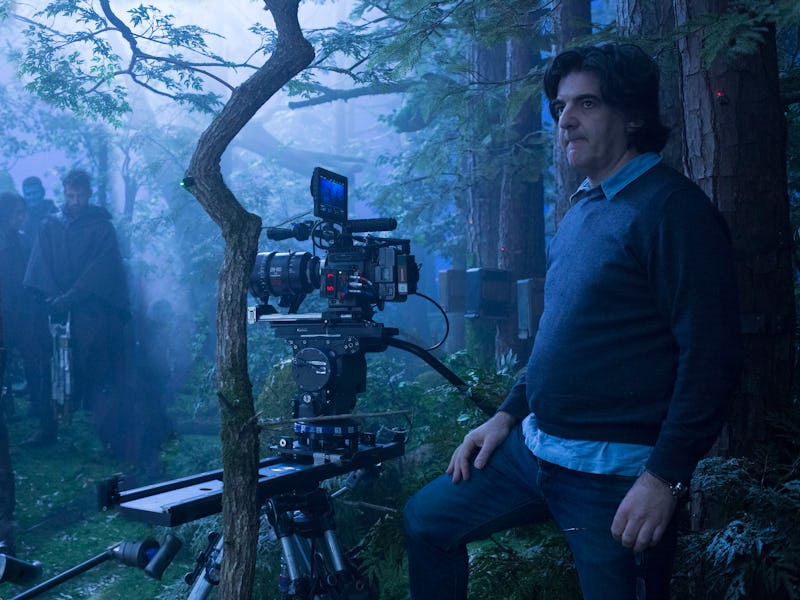'Guardians Vol. 2' Made Cinema History With a High-Tech Camera
Director of photography Henry Braham used a powerful but compact camera for the Marvel spectacle.

The two Guardians of the Galaxy movies, which have grossed $1.51 billion worldwide, have set themselves apart from many superhero flicks, using pop culture references and witty characters. But in the sequel, there was also an effort to blaze a trail with cutting edge visual technology. Director James Gunn and British cinematographer Henry Braham (The Legend of Tarzan) set out to create the first whole movie filmed at 8K resolution. And with the help of a powerful but portable camera, Guardians of the Galaxy Vol. 2 looked and felt different than any Marvel movie before it.
The sequel to Marvel’s 2014 sci-fi hit was filmed in 8K, the highest resolution to date, using the Red Weapon 8K, which was released in 2015. Selected for its robust depth of information, the Vol. 2 filmmakers “wanted a large-format camera because of the visual ambition of the movie,” Braham tells Inverse. But while Guardians of the Galaxy Vol. 2 is designed for screens like IMAX, the camera is relatively small. This is another innovation by Red that makes the tech more usable, a feature that has historically led to widespread adoption. At less than four pounds (without rigs) and the size of two footballs, it offered the filmmakers versatility and flexibility.
Although the Guardians’ second outing is a theatrical extravaganza, Braham likened filming to a documentary. “I don’t mean anything is random,” Braham contends, “but the nuances of how the camera moves, that is the documentary element. James [Gunn’s] process of making the movie is that he likes spontaneity from take to take, as the actors find their rhythm.”
Henry Braham on the set of 'Guardians of the Galaxy Vol. 2' with Zoe Saldana ("Gamora").
And like a documentary, a chunk of Vol. 2 — Braham estimates 85 percent — was shot handheld with one camera. But unlike documentaries or viral YouTube videos, this quality is invisible thanks to another piece of innovation: the Stabileye, a camera rig developed by David Freeth, a London-based technician who also worked on gyro-stabilization guidance systems on submarines. By going handheld, Gunn and Braham could be flexible and move the camera in ways most tentpoles with big cameras can’t. Take, for example, the opening credits, starring the lovable Baby Groot dancing to Electric Light Orchestra’s “Mr. Blue Sky” as the Guardians get wrecked by a humongous tentacle monster.
For that sequence, Braham worked closely with other departments, from visual effects to wardrobe, to ensure the audience believes there’s actually a dancing tree on the screen. “With any animated character, when I’m looking through the camera, I’m taking account of where that invisible character is playing the scene,” Braham explains. For the Groot number specifically, the scenes were shot on physical sets surrounded by blue screen, which is where Braham had to work with the film’s VFX team — led by Chris Townsend — to get an accurate sense of scale for Baby Groot and the world he inhabited. “Visual effects is an extension of what the Renaissance painters discovered, in terms of perspective drawing, of aerial perspective, to create the impression of reality in two dimensions.”
Braham on set with Elizabeth Debicki ("Ayesha").
Because of the complexity of the scene, which includes camera blocking and stunt work, the opening Groot dance took a big team working over three months in pre-visualization. When it came time to roll the cameras, it took three days. Three days of “Mr. Blue Sky,” playing over and over. “He plays music, those specific pieces, he plays back on the set all the time,” Braham says. “It’s crucial to his process.”
To Braham, a few things made Guardians of the Galaxy Vol. 2 a challenge: its cult sci-fi aesthetic, which is unlike almost all other Marvel movies before, as well as the onslaught of color. One can’t help but think of the original Gene Colan comics when watching Vol. 2, but Braham didn’t look to the comics at all. “The source material for me is the director and the script and my own instinct,” Braham explains.
Regardless of inspiration, “the intensity of color” was the most complicated thing about shooting Vol. 2. “Most movies, we shoot with a limited color palette. We use light and shade as the means of creating an atmosphere.” But Vol. 2 is an explosion of color, even compared to the 2014 original, which was shot by cinematographer Ben Davis. Thankfully, Braham’s previous experience with vibrant palettes, such as his work on the 2005 fantasy Nanny McPhee, prepared him for the Marvel Universe: “So I had insight into the complexity of this before Guardians. But actually getting that aesthetic right is probably the hardest thing.”
Braham with director James Gunn (right) on the set of 'Guardians of the Galaxy Vol. 2.'
Ultimately, it wasn’t the cameras or the rigs that made Guardians of the Galaxy Vol. 2 look and feel special. It was the people. But cameras and rigs sure do help. The filmmakers worked closely with Red for four months to develop the format they would shoot Vol. 2 on, and Marvel was fine with it. “Quite specifically, [Marvel] never said, ‘Look, we’ve got a history of making very successful movies; this is our process, stick to that.’ They never said that.”
In fact, Marvel told Braham the opposite. “As I started the process of figuring out the shoot and talking to James, they said, ‘We’re about moving forward, we’re not about looking back.’”
Marvel’s Guardians of the Galaxy Vol. 2 is in theaters now.